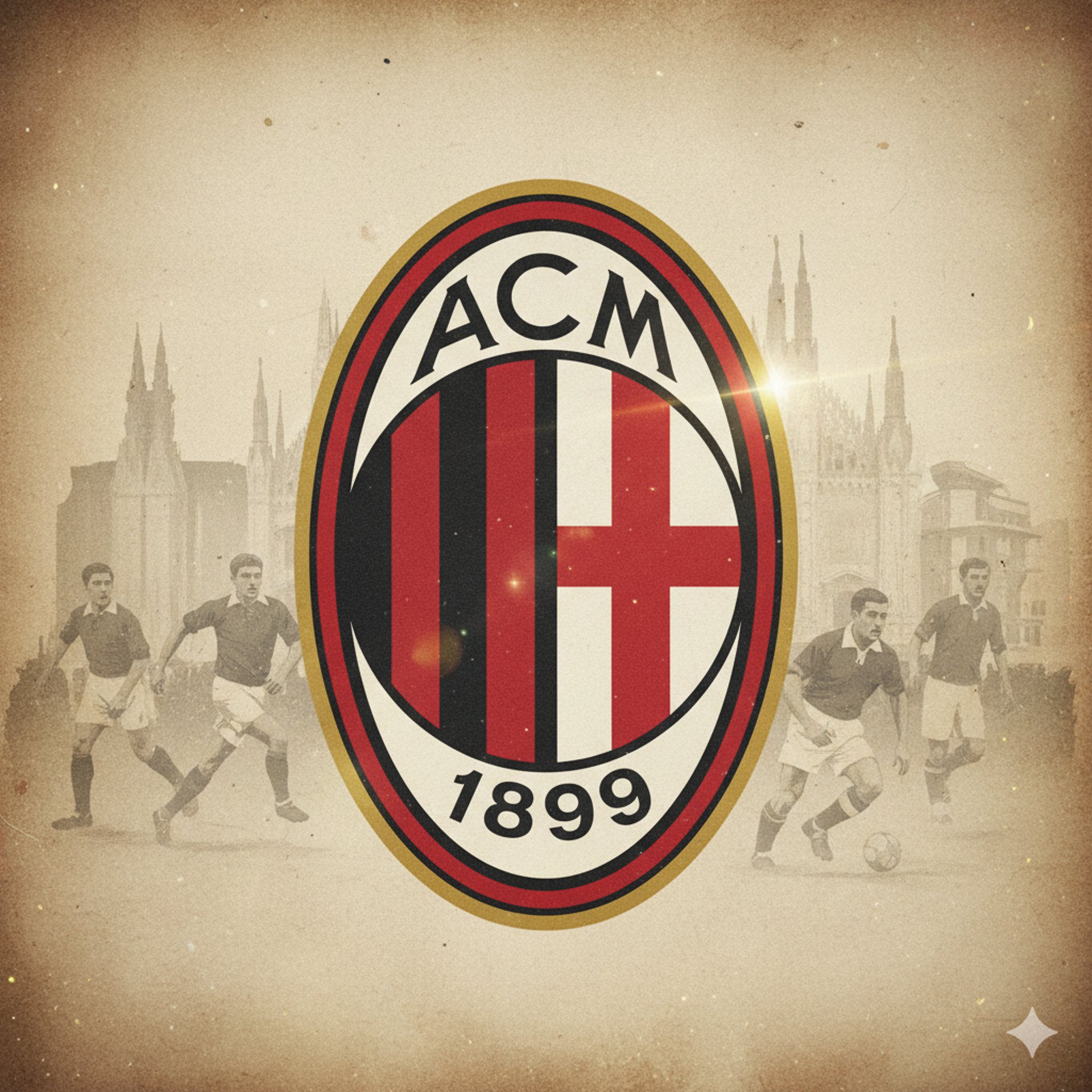
The Birth of a Legend: AC Milan's History
Dive into the passionate founding story of AC Milan. From its 1899 origins with English pioneers Herbert Kilpin and Alfred Edwards, uncover the legendary choice of "red as fire, black as fear" and the club's first Scudetto triumph in 1901. This deep-dive article explores how a traumatic 1908 split forged the fierce Derby della Madonnina, shaping one of football's greatest rivalries. A must-read for every Rossoneri fan and football history enthusiast.
BLOG
RedBlack Pulse
9/16/202510 min read
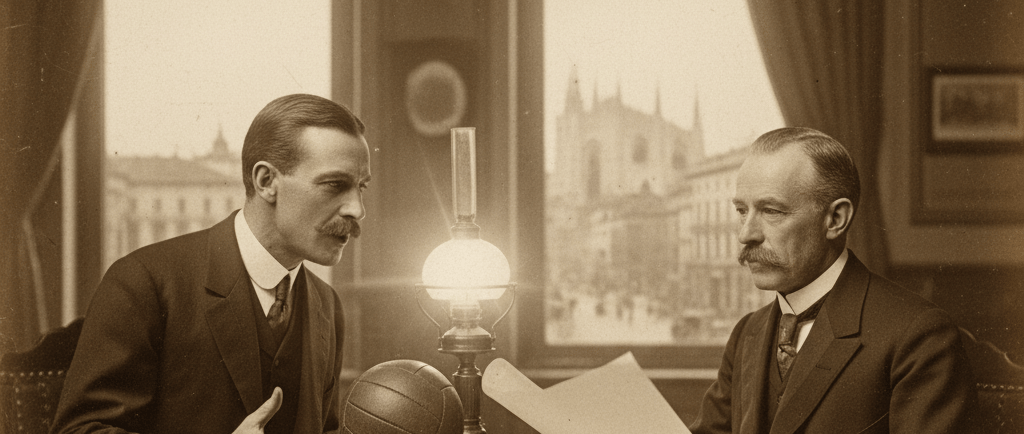

The Founding Act of the Myth: The Professional and Passionate Birth of AC Milan
Introduction: Milan 1899 - Football in a City of Tailors and Dreamers
The history of the Associazione Calcio Milan does not begin on a football pitch, but in the crucible of late 19th-century Milan, a metropolis in full industrial and cultural ferment. It was a time when the social fabric was still deeply divided: the nobility favored elite disciplines such as horse riding and fencing, while for the vast majority of the population, composed of factory workers who toiled for up to 13 hours a day, the concept of "leisure time" was an almost unimaginable luxury. In this context, the introduction of "football," a game that in England was already becoming a "mass proletarian cult" , presented itself as a radical innovation.
The genesis of AC Milan was not a random event, but the result of an extraordinary and almost mystical symbiosis between two complementary figures. On one side was the irrepressible passion, the pioneering vision, and the rebellious soul of Herbert Kilpin, an English tailor and pioneer who had to "kick a ball to breathe." On the other, the institutional respectability and formal solidity of Alfred Edwards, a businessman and British vice-consul, who gave the project an aura of seriousness essential for its success. The club was conceived not only as a simple sports team but as an identity expression capable of reconciling the British roots of the game with the vibrant and ambitious soul of Milan.
This report aims to explore in detail the fundamental stages of this legendary birth. The figures of the two founders and their crucial roles will be examined in depth, analyzing the symbolic and meticulous origin of the red and black colors and the crest. The first triumph, the iconic Scudetto of 1901, a moment of consecration that broke a sporting hegemony, will then be examined. Finally, the painful "original sin" of the 1908 split will be traced, a traumatic event that, paradoxically, generated the most intense and iconic rivalry in world football: the Derby della Madonnina.


Chapter I: The Founding Fathers: The Visionary and the Institution
1.1. Herbert Kilpin, the Devil's Tailor: Pioneer and Master of Passion
Herbert Kilpin, born in Nottingham on January 24, 1870, was the ninth child of a butcher. His life was a blend of profession and passion: he worked in the textile industry, first in a lace warehouse in Nottingham and then moving to Milan to continue in the same industry. However, his true calling was football. His obsession with the game manifested early, at just 13 years old, when he founded a small amateur club that he named "Giuseppe Garibaldi," whose players, in honor of the Italian hero, wore typical red jerseys. This choice was not casual but demonstrated an early and deep affinity with the Italian identity, a sign of a destiny that would lead him to make an indelible contribution to the country's sporting history.
Kilpin's figure is that of a true pioneer and "maverick." After playing as an amateur in England and then for Internazionale Torino, he moved to Milan in 1898. Here, in 1899, along with other compatriots and a group of Italians, he was among the founding members of the "Milan Foot-Ball and Cricket Club." Although he was, in all likelihood, the most experienced man in the group, Kilpin held the dual role of player and manager. He was a man of robust temperament, with legendary anecdotes that portray him drinking whiskey before and after matches to celebrate victories or numb defeats. His austere, mustachioed figure, immortalized in an iconic photograph with his striped jersey and bowler hat, is the emblem of a romantic and pioneering era of football.
Kilpin's fate was marked by a bitter irony: he died in Milan in 1916, at only 46, probably due to his smoking and drinking habits. For almost a century, his grave remained anonymous and forgotten, lost in the municipal cemetery of Milan in a section reserved for Protestants. It was only in the 1990s, thanks to the tireless research of an amateur historian named Luigi La Rocca, that his burial was located. On the occasion of the club's centenary in 1999, AC Milan paid for a new tombstone and, in 2010, Kilpin was finally inducted into the Famedio, the pantheon where Milan's most illustrious citizens rest. This story of oblivion and rediscovery is a powerful testament to how greatness, even if forgotten, can re-emerge. His story shows that Milan was not born as a simple pastime but as the result of a personal mission, infused with the fire and determination of Kilpin, a true "evangelist" who spread the word of football in Italy.
1.2. Alfred Edwards: The Institutional President and Organizational Soul
If Kilpin represented the visceral soul of football, Alfred Edwards embodied its structure and institutional respectability. Born in Skyborry, England, on October 12, 1850, he had moved to Milan for work. In the city, Edwards had achieved a position of great prestige, serving as the British vice-consul and becoming a prominent figure in Milanese high society. It was precisely his reputation and his overall vision that ensured that the newborn Milan Foot-Ball and Cricket Club had a solid and authoritative foundation.
Edwards was one of the twelve men who met on December 13, 1899, at the Hotel du Nord to found the club and was immediately appointed its first president. Under his leadership, Milan was conceived with a dual soul: a section dedicated to football, entrusted to Kilpin, and one to cricket, managed by Edward Berra. This synergy between the almost "anarchic" and pioneering passion of Kilpin and the formal and institutional approach of Edwards was the key element in Milan's genesis. The club's initial success was the result of this perfect alchemy between the two founding souls.
A fascinating detail, which testifies to his prophetic vision, comes from a contemporary account: Edwards was convinced that to compete with more advanced football cities like Turin and Genoa, Milan needed two clubs to ensure the growth of football in the city. This statement sheds new light on the subsequent split and the birth of Inter, almost as if the rivalry that would mark the club's history was inscribed in its DNA from its very conception. Edwards remained in office until 1909, after which he returned to England.
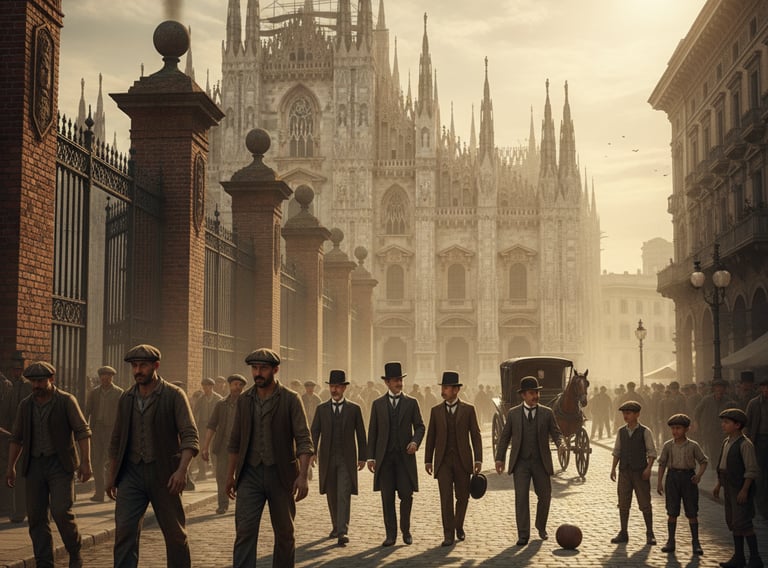

Chapter II: Red as Fire, Black as Fear: The Birth of Symbols
2.1. The Identity Written on the Colors: The Fire of the Devil
The founding act of Milan was accompanied by a statement that would become legendary. Herbert Kilpin, inspired by his vision and his past, chose the colors that would forever define the club's identity. The phrase attributed to the founder is a true manifesto: "We will be a team of devils. Our colors will be red like fire and black like the fear we will invoke in our opponents!" This was not a simple aesthetic choice or a tribute. It was the mission statement of a team that, from day one, had the ambition to dominate.
The origin of these iconic colors is rooted in Kilpin's personal history. He was inspired by the jerseys of Notts Olympic, a team from Nottingham he had played for. Red symbolized fire, the passion of the Milanese players, while black represented the fear they would instill in their rivals. This chromatic choice and the subsequent adoption of the nickname "The Devil" were not acquired over time but were born from the very act of the club's foundation. This aspect reveals a clear identity vision from the beginning, a rare trait in the football of those pioneering years, and shows how the metaphor of "fire and fear" shaped the winning mentality and the very essence of the club.
2.2. The St. George's Cross and the Milanese Soul
The identity of the newborn Milan was not limited to the choice of colors. The club's first crest was a circle, inside which, on the left, were the red and black stripes, while on the right was the red cross on a white shield of the St. George's Cross, the iconic symbol of Milan.
The inclusion of the St. George's cross from day one is a crucial detail. Although Milan was founded largely by English expatriates, their intention was to create a club that was viscerally Milanese. This gesture is a testament to a deep identity strategy: a club that, despite its British roots, immediately and unhesitatingly wanted to root itself in the soul of the city. This visual integration refutes the idea of a "foreign" club and emphasizes its immediate and profound connection with the territory. The subsequent evolution of the crest, with variations of the acronym and the introduction of the golden star for the tenth Scudetto, has always been a manifestation of the club's unique DNA.
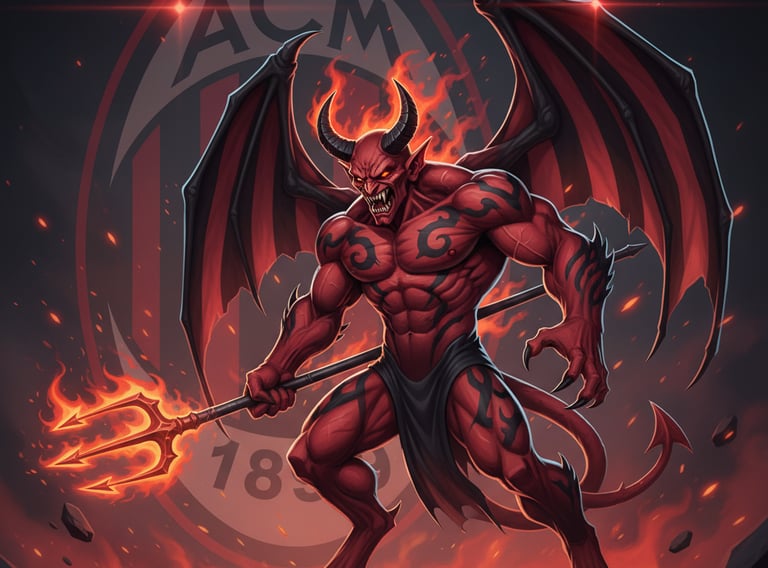

Chapter III: The Triumph of the Pioneers and the Consecration of the Myth
3.1. 1901: The First Rossoneri Miracle
In 1901, Milan was a rapidly rising sports club, but Italian football was still dominated by Genoa, which had won the first two editions of the championship. The 1901 season represented the turning point and consecration for the Rossoneri club. After winning the Medaglia del Re for the second consecutive time , the team focused on the federal championship. Their journey was as short as it was triumphant.
The semifinal was played in Turin against Juventus. Milan won with a clear 3-2, thanks to goals from Negretti and Kilpin, who proved to be the team's most decisive players that season. The climax of the season was the final, which was played in Genoa on May 5, 1901. Milan faced the reigning champions of Genoa, and the outcome was a historic 3-0 victory, a result that ended the Ligurian hegemony and marked the conquest of the first Scudetto in the club's history. The success of 1901 was not a simple sporting victory, but a foundational act that sanctioned Milan's transition from a group of dreamers to a consolidated reality. It was a declaration of power and a first sign of the potential the team would express in the years to come, laying the foundations for subsequent victories in 1906 and 1907.
Milan's superiority in those years was not only the result of passion and determination but also of tactical innovation. The team, composed mostly of British athletes , used the "2-3-5" scheme, known as the "Cambridge pyramid," a formation that testified to the club's technical superiority and avant-garde vision in that pioneering period of Italian football.
3.2. From Campo Trotter to the Foundation of a Home
Milan's growth path was also a logistical evolution. In the early years, the team played on different pitches: from Campo Trotter in Piazza Doria to Campo Acquabella , and subsequently to Campo Milan at Porta Monforte. This transition symbolizes the passage from an amateur club to an increasingly structured reality.
The turning point came in 1926, when President Piero Pirelli, at his own expense, had a new stadium, the San Siro, built, which became Milan's exclusive home. The inauguration of the facility, which took place on September 19 of the same year, is a historic event for a powerful narrative detail: the first match was played precisely between Milan and Inter. The event, won by Inter 6-3, shows that the fate of the derby was already inextricably linked to the history of the new stadium and the future of the two clubs.
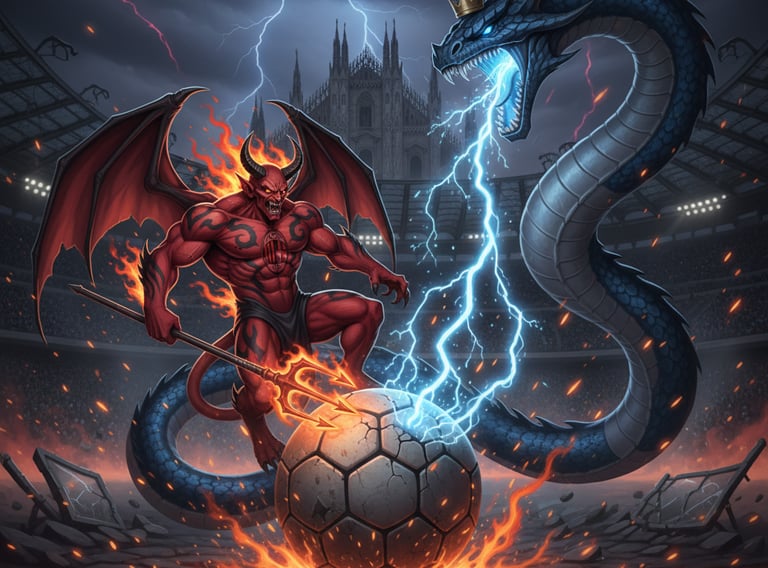

Chapter IV: The Great Schism: The Original Sin that Created the Eternal Rival
4.1. A Disagreement on Identity, not just on Foreign Players
1908 was a year of turning point and a foundational trauma for Milan. The formal cause of the split was the "disagreement over the signing of foreign players." The debate that ensued was bitter and profound: the dissenting members, who met on March 9, 1908, in a Milanese restaurant, felt that Milan did not have a strong enough position to defend the presence of non-Italian athletes on the teams, unlike what they desired.
This divergence, however, can be interpreted not only as a regulatory problem but as a profound philosophical and identity crisis. Milan, despite having international roots, had chosen to root itself deeply in Milan, an aspect that, according to the secessionists, limited its openness to every nationality. The choice to name the new club "Internazionale" is the clear demonstration of this ambition. The split was therefore not a trivial quarrel but a profound identity crisis, a wound that generated what can be called the "original sin" of Milanese football. The exclusion of Milan from the following championship, as a consequence of this fracture, was a direct and painful consequence that marked a moment of great difficulty for the club.
4.2. The Birth of the Derby della Madonnina
From the wound of the split, one of the most famous, passionate, and intense rivalries in world football was born. The birth of Internazionale gave rise to the "Derby della Madonnina" , whose name evokes the statue of the Virgin Mary that towers over the Duomo of Milan. This name itself inseparably links the sports rivalry to the soul of the city. The first official derby was played on January 10, 1909, and was won by Milan 3-2, marking the beginning of a contest that would write pages of history and passion. The rivalry between the two teams, despite the successes of both, has always been characterized by a deep intensity, which has sometimes crossed the boundaries of the field.
Conclusion: The Immortal Legacy of a Devil
The birth of AC Milan is a story that transcends simple sports reporting. It is a tale of vision and passion, of compromise and conflict, which has shaped a unique and lasting identity. The club was born from the perfect fusion of the passion of the pioneer Kilpin, who had football in his blood and spread its word, and the institutional vision of Edwards, who guaranteed the solidity and respectability necessary for success. Its symbols, the red and black colors that evoke fire and fear, and the crest with the St. George's cross, are the manifestation of a precise and lasting identity, conceived to unite British roots and the Milanese soul.
The first Scudetto, won in 1901, was the act of consecration that ended Genoa's hegemony and projected Milan among the great powers of Italian football. The subsequent split, a traumatic and painful event, has paradoxically forged its greatest and most iconic opponent. Milan has shown a remarkable ability to face and overcome adversity.
The spirit of the founders has remained a common thread that has run through the club's entire history. It manifested itself with the arrival of legends like the Swedish trio "Gre-No-Li" in the 1950s , which brought the club back to success, and reached its peak with the European dominance of the "Immortals" of Arrigo Sacchi and Fabio Capello in the 1980s and 1990s. Kilpin's phrase, "the fear we will invoke in our opponents," has become a global reality.
From a group of English expatriates who met in a hotel room in Milan, to one of the most successful and recognized clubs in the world, Milan's story is a living testament to the power of passion and vision. The myth of the Devil, born on that December 16, 1899, continues to ignite the hearts of fans, demonstrating that an idea, if nurtured by a strong soul, can become immortal.
